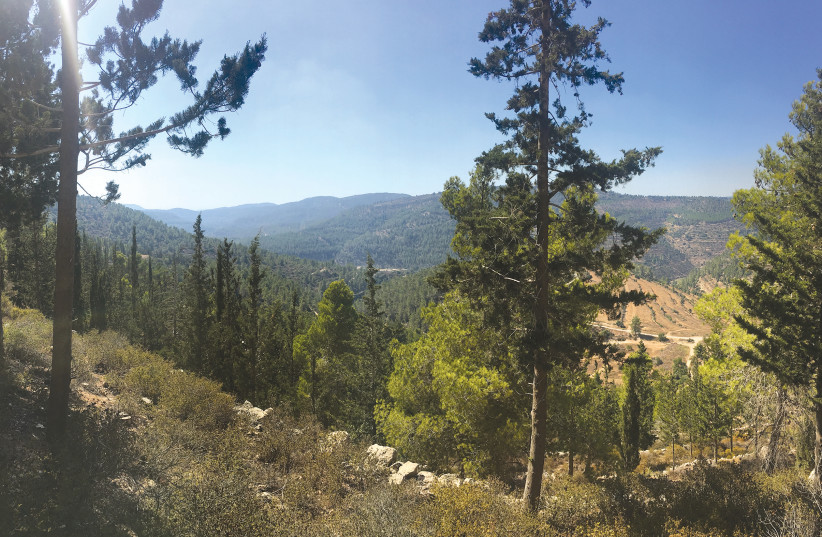I’m standing at the top of a desert cliff, a thick rope in my hand. After I loop the rope through a metal ring, I grab both ends and carefully descend a tawny rock wall. I know what’s waiting for me at the bottom, and at this point in the morning, I can’t say I’m looking forward to it. Soaking wet and cold on this warm spring day, I lower myself into yet another gev or standing pool, one of the many that lay along the challenging Nahal Darja trail in the Judean Desert near the Dead Sea.
I reach the end of the rope, and there is nothing left for me to do but jump. At least, I notice before I take the plunge, the pool below is a turquoise blue, as opposed to the rich algae green tone of more stagnant desert pools. I let go of the rope and feel myself falling into the freezing cold water.
May. This is the month of blossoming flowers, birds, and buzzing bees. It’s also the time of year when we mourn our fallen soldiers on Remembrance Day, then celebrate our nationhood on Independence Day. But for hikers in Israel, the arrival of the month means something else: now’s the time to head to desert pools before they disappear along with the rain.
Before moving to Israel from the swamp town of New Orleans, I didn’t even know that desert pools existed. In my imagination, mostly formed from movies and cartoons, deserts were a hot and sandy wasteland, devoid of any form, plant life, or geological features. I imagined that a hike in the desert would be indescribably boring – what could be fun about trudging through a featureless landscape, over dune after dune of sand?
After exploring Israel’s deserts on many hiking trips since moving here 20 years ago, I am now familiar with a desert land that includes acacia trees and ibex, miniature winter flowers, cute sand mice, and singing black birds with orange bellies. In this desert, there are rocks and crevices, mountains and canyons. Desert flash floods occur here every winter, washing through canyons and causing rainwater to become trapped in rocky pits along the way. These desert pits (like the ones in Nahal Darja) are called gevim.
Anyone who has studied Tanach has probably stumbled across a reference to Israel’s desert pools. In the third chapter of Kings II, the kings of Judah and Israel join forces to conquer an enemy; they set out through Midbar Edom (translated as the wilderness of Edom), south of the Dead Sea. The world “wilderness” evokes images of wild forests and overgrown shrubbery, but this wilderness is anything but overgrown. This part of the country is also known as the Negev: it’s rocky, sparse, and bone-dry in most places. In the story from Kings, the word “midbar” could also be translated as “desert.”
Desert miracle: Gevim revelation
As befits any good desert journey, the Israelite troops in this story run out of water. Then, they turn to Elisha the Prophet for assistance from God. After a brief musical interlude, Elisha receives a prophecy: The nahal, or desert canyon, will be full of “gevim, gevim”. God says, “You will see no wind and no rain, but the canyon shall be filled with water, and you and your cattle and pack animals shall drink.”
To those unfamiliar with Israel’s desert terrain, this may seem like a miraculous distortion of the laws of nature. But the sudden appearance of water in the form of flash floods is actually quite common in the wintertime, as rainstorms near Jerusalem cause water to rush down through dry desert canyons near the Dead Sea. To those ancient Israelites, the appearance of water in dry desert pools would have been a natural occurrence.
The Israelites did, in fact, awaken in the morning to fresh water filling the pools. But the story of the gevim didn’t end there. Gazing in from a distance, the Moabite enemy saw the reflection of the rising sun in the newly formed pools. To them, the shimmering red liquid looked like pools of blood. They imagined that the kings of Judea and Israel had fought among themselves in the night and murdered one another. Off guard and overeager, the Moabites rushed in to retrieve the spoils, and were slaughtered by the Israelite army.
Whenever I swim in desert pools, I notice the way the color of the pool matches the sky. On gray days, the gevim seem colorless and muddy. On bright days, they seem blue and serene. And at sunset? They reflect the red-orange color of the sky. That’s when I recognize the magnificence of the natural miracles depicted in our holy books, which serve as an example for our modern lives.
As we enter this time period of celebration for the State of Israel, one can’t help but feel gratitude for the countless miracles of our nation’s own existence. After the Holocaust, our small and downtrodden people somehow managed to establish our own state and defeat numerous hostile neighbors. By understanding Torah through the lens of Israel’s terrain, we see that natural events are often miracles in disguise.

